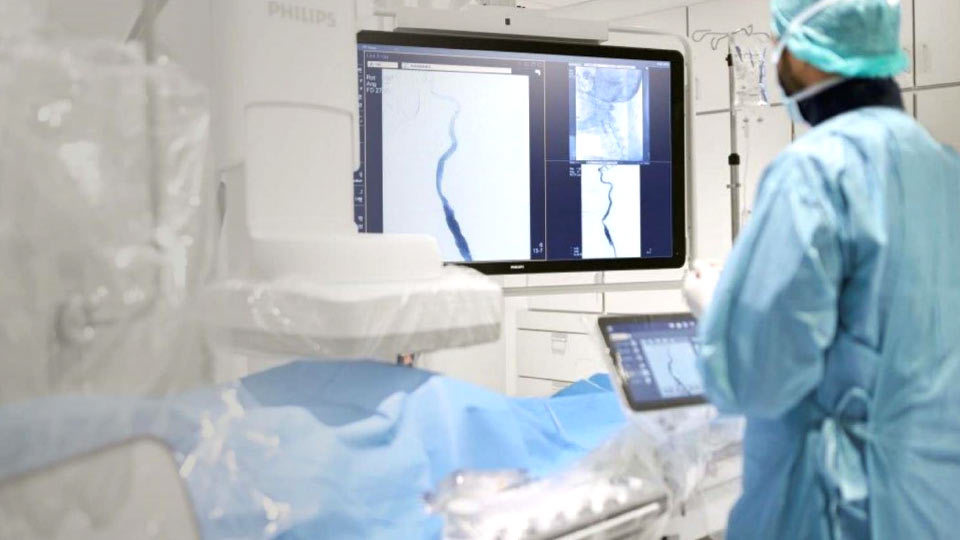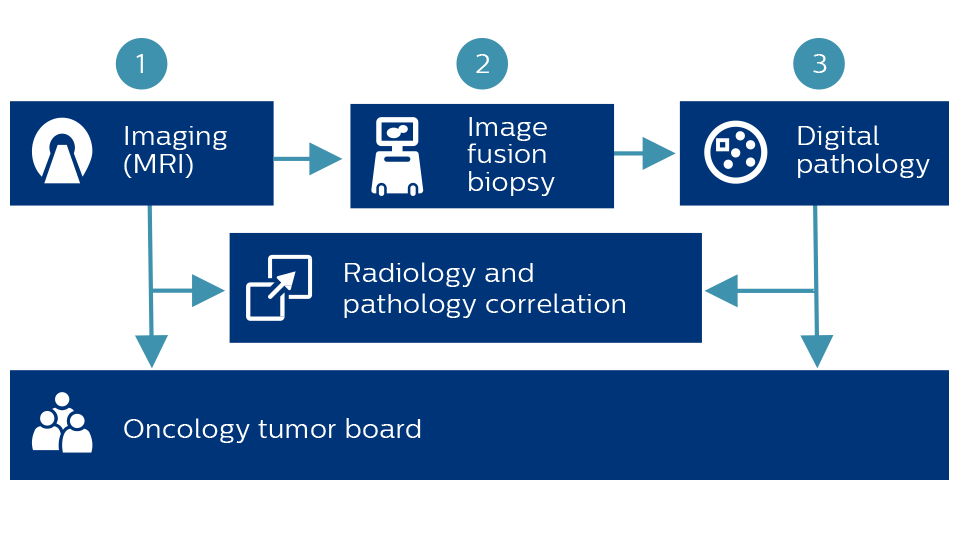Oncology
What if you could decrease the uncertainty that complicates the oncology pathway?
Under-treatment. Over-treatment. Neither is desirable, and precise diagnosis is critical to determine the best treatment pathway, optimizing tumor control while sparing healthy tissue. See what various healthcare teams are doing right now to address the diagnostic uncertainty that can complicate cancer treatment. This article will give you an overview of the advances for earlier, more accurate diagnosis and staging in prostate cancer and shorter, more effective treatment pathways in lung cancer.

At a glance
Challenge Accuracy in diagnostics and treatment is a challenge in many types of cancer, including prostate and lung cancer.
Solution Philips integrated solutions are guiding early, accurate cancer diagnosis and treatment.
Results With prostate cancer, 30% improvement in detection of aggressive cancer1
In lung cancer, more than 91% sensitivity for malignancy and 84% diagnostic yield for small lung nodules2
At a glance
Challenge Accuracy in diagnostics and treatment is a challenge in many types of cancer, including prostate and lung cancer.
Solution Philips integrated solutions are guiding early, accurate cancer diagnosis and treatment.
Results With prostate cancer, 30% improvement in detection of aggressive cancer1
In lung cancer, more than 91% sensitivity for malignancy and 84% diagnostic yield for small lung nodules2
Share this article
For prostate cancer, diagnostic uncertainty is affecting treatment
First, a look at prostate cancer. A 2020 study in the New England Journal of Medicine sums up the challenges of accurately diagnosing prostate cancer. Clearly, current approaches are not working as well as they should be.
The current approach to prostate cancer diagnosis is characterized by a considerable degree of diagnostic uncertainty. This uncertainty has contributed to both overtreatment and undertreatment and has left the medical community uncertain of the most effective method for diagnosing prostate cancer." 3
How to improve diagnostic accuracy in prostate cancer
Fusing pre-biopsy MR images of the prostate with ultrasound-guided biopsy images in real time provides excellent delineation of the prostate and suspicious lesions, as well as clear visualization of the biopsy needle path. Combining tracking and navigation with real-time imaging brings precision targeting for the biopsy samples.
Fortunately, precision targeting and enhanced image-guided biopsy for prostate cancer are allowing for greater diagnostic certainty than previous approaches. It starts with connecting radiology and urology. Current methods of prostate cancer screening are somewhat unreliable and can lead to many uncertainties. Prostate biopsy, the most common method of detection,3 is a challenge because of difficulties in visualizing not only the entirety of the prostate, but also the location of the biopsy needle. Transrectal ultrasound-guided prostate biopsy (TRUS), the current biopsy standard, commonly suffers from poor image resolution, and the biopsy needle often passes through tumor-free areas of the prostate - potentially missing the tumor entirely.
What if you had true multi-disciplinary collaboration across departments or sites?
Connecting radiology and urology to improve diagnostic accuracy for informed treatment decisions helps reduce uncertainty for clinicians and patients. This precision targeting with enhanced image guided biopsy is making a real difference in the diagnosis of prostate cancer.
Dr. Christof Kastner on reducing the number of biopsies needed
We're saving 40% of biopsies. Not only is that a saving in monetary terms, it's also a saving of patients’ side effects. It's a saving of further investigations downstream." *
Christof Kastner, PhD, FRCS (Urol), FEBU
Consultant Urologist & Prostate Cancer Lead, Cambridge University Hospitals
A paradigm shift for lung cancer care
Next, let’s take a look at lung cancer. Lung cancer is the leading cause of cancer deaths globally, responsible for 1.7 million deaths worldwide.4 The rise in screening programs for lung cancer means that more patients are diagnosed at an earlier stage. Detection of lung cancer when it is most curable will reduce the mortality numbers. But this comes with its own challenges.
Every week counts: there is a 5% increase in mortality for every week in delay of treatment for lung cancer5
Small peripheral nodules are typically more complex to reach and localize during biopsy. As a result, many patients with small lesions are monitored for nodule growth over time. This ‘watch and wait’ approach can cause patients considerable distress as they face repeat visits for definitive diagnoses, staging and then treatment of the disease. When diagnosed early and resected immediately, a lung cancer patient’s chance of survival at 10 years jumps to 92%.6
Cone beam CT with augmented fluoroscopy: An absolute game changer
More accurate and less invasive methods are being implemented in clinical practice. Even barely visible nodules of just 5 mm can be detected and treated through new advanced bronchoscopic techniques. Advanced imaging can be combined with other navigation technologies to achieve high-precision diagnosis and fulfill the need to combine diagnosis and staging with minimally invasive therapy in one room. Diagnostic yields of 84% have been reported for biopsy of small peripheral pulmonary nodules with Philips Cone beam CT and augmented fluoroscopy in combination with other navigational technologies.2
Dr. Pritchett explains how he gets the highest diagnostic yield and performs an endobronchial ablation
This is a very exciting time in the world of interventional pulmonology and advanced bronchoscopy. There’s been an explosion in the research and development of newer technologies."
Dr. Michael Pritchett
Pulmonologist, Pinehurst, NC
All-in-one diagnosis and treatment of lung cancer
Based on simulation results and published clinical studies
100%
Lung tumor depiction using high-quality cone beam CT2,7,8
84%-91%
From 84% - 91% diagnostic yield for small lung nodules2
iVATS
Proven ability to combine tumor marking and VATS resection in single room9
96%
96% are satisfied with how easy it is to use Philips Azurion10
Decreasing the uncertainty that complicates the treatment of both prostate and lung cancer
It is possible to have earlier, more accurate staging in prostate cancer and shorter, more effective treatment pathways in lung cancer. We’re ready to help you learn more about the possibilities.
How Philips can support you
See how Philips helps you connect radiology and urology like never before
Reduce diagnostic uncertainty by connecting more parts of the pathway, combining tracking and navigation with real-time imaging to bring precision targeting for biopsy samples.

Go deeper
Study
Impact of MRI-targeted biopsy in detection and classification of prostate cancer
Are you ready for a new era in lung cancer treatment?
Shorten and improve the care pathway with the Philips Azurion Lung suite, a revolutionary 3D imaging and navigation platform that supports high precision diagnosis and minimally invasive therapy in one room.

Go deeper
Are you interested in learning more about how these solutions can help you address your challenges?
Case study
Cone Beam CT guided endobronchial biopsy assisted by 3D live fluoroscopy overlay with tumor segmentation
Study
Cone-beam CT with Augmented Fluoroscopy Combined with Electromagnetic Navigation Bronchoscopy for Biopsy of Pulmonary Nodules

Get in contact with our Oncology specialists
Share this article
At a glance
Challenge Accuracy in diagnostics and treatment is a challenge in many types of cancer, including prostate and lung cancer.
Solution
Philips integrated solutions are guiding early, accurate cancer diagnosis and treatment.
Results With prostate cancer, 30% improvement in detection of aggressive cancer1
In lung cancer, more than 91% sensitivity for malignancy and 84% diagnostic yield for small lung nodules2
Share this article
Other challenges you might be facing
See what other thought leaders have to say

More information about Oncology Solutions
Find out how Philips can help you enable a clear care pathway with predictable outcomes for every patient.
* Results from case studies are not predictive of results in other cases. Results in other cases may vary.
1. Siddiqui MM, Rais-Bahrami S, Turkbey B, et al. Comparison of MR/ultrasound fusion–guided biopsy with ultrasound-guided biopsy for the diagnosis of prostate cancer. JAMA. 2015;313(4):390-397. 2. Pritchett M, et al. Cone beam CT-guided endobronchial biopsy assisted by augmented fluoroscopy. Chest. 2017;152.4: A 8 87. 3. Ahdoot M, Wilbur AR, Reese, SE, et al. MRI-targeted, systematic, and combined biopsy for prostate cancer diagnosis. N Engl J Med. 2020;382:917-928 4. International Agency for Research on Cancer, World Health Organization. Press Release N°263. Latest global cancer data: Cancer burden rises to 18.1 million new cases and 9.6 million cancer deaths in 2018. 12 September 2018. 5. Survival after community diagnosis of early-stage non-small cell lung cancer. The Am J Med. 2014;127 (5):443-449. 6. International Early Lung Cancer Action Program Investigators. Survival of patients with stage 1 lung cancer detected on CT screening. N Engl J Med. 2006;355:1763- 1771 DOI: 10.1056/NEJMoa060476 7. Abi-Jaoudeh, Nadine, et al. Prospective randomized trial for image-guided biopsy using cone-beam CT navigation compared with conventional CT. J Vasc Interv Radiol. 2016 27.9 1342-1349. 8. Yan, Gao-Wu, et al. A systematic review and meta-analysis of C-Arm Cone-Beam CT-guided percutaneous transthoracic needle biopsy of lung nodules. Pol J Radiol. 2017;82:152. 9. Zhao, Ze-Rui, Rainbow WH Lau, and Calvin SH Ng. Hybrid theatre and alternative localization techniques in conventional and single-port video-assisted thoracoscopic surgery. J Thorac D. 2016; 8.Suppl 3: S319. 10. Results obtained during user tests performed in the period of November 2015 - February 2016. The tests were designed and supervised by Use-Lab GmbH, an independent and objective usability testing engineering consultancy and user interface design company. The tests involved 31 US-based clinicians (16 physicians and 15 technicians) and 30 European-based clinicians (15 physicians and 15 technologists), who performed procedures using Azurion in a simulated interventional lab environment.
doi: 10.1056/NEJMoa1910038







